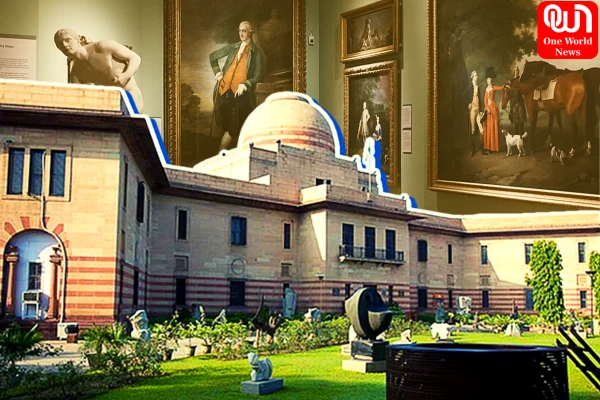Experience Artistic Marvels At The National Gallery of Modern Art , Delhi

Discover the Artistic Treasures of Delhi: A Journey Through The National Gallery of Modern Art, Delhi
The National Gallery of Modern Art, Delhi is a prestigious cultural institution that has been showcasing contemporary art for over six decades. It is situated in the historic Jaipur House, which was designed by the renowned British architect Sir Edwin Lutyens.
The National Gallery of Modern Art (NGMA) is considered to be one of the leading art museums in India, and its collection includes works by some of the most influential Indian artists of the 20th century.
History
The NGMA was established in 1954 with the aim of promoting and showcasing modern and contemporary art in India. Over the years, the institution has played a crucial role in fostering a vibrant art scene in the country. The gallery’s collection includes over 17,000 works of art, ranging from paintings, sculptures, photographs, and mixed media installations.
Events
One of the unique features of the NGMA is that it provides a platform for artists from all over India to showcase their work. The gallery regularly hosts exhibitions that highlight the work of established artists as well as emerging talents. These exhibitions are curated with great care, and they offer visitors a glimpse into the dynamic and diverse art scene in India.
Apart from exhibitions, the NGMA also organizes talks, seminars, and workshops on various aspects of modern and contemporary art. These events provide an opportunity for artists, critics, and art enthusiasts to come together and engage in meaningful discussions about art and its role in society.
Collections
The NGMA’s collection includes works by some of the most influential Indian artists of the 20th century, such as Rabindranath Tagore, Nandalal Bose, Amrita Sher-Gil, and Raja Ravi Varma. The collection also features works by contemporary artists such as Subodh Gupta, Bharti Kher, and Anish Kapoor. The gallery’s collection is constantly evolving, and new works are added to it regularly.
One of the highlights of the NGMA’s collection is the works of Amrita Sher-Gil. Sher-Gil is considered to be one of the most important Indian artists of the 20th century, and her works have been compared to those of Frida Kahlo and Gustav Klimt. The NGMA has a significant collection of Sher-Gil’s paintings, which includes some of her most iconic works such as “Self-Portrait” and “Bride’s Toilet.”
Architecture
Another important aspect of the NGMA is its architecture. The building that houses the gallery, Jaipur House, was designed by Sir Edwin Lutyens, who is also credited with designing many of the iconic buildings in New Delhi, including the India Gate and the Rashtrapati Bhavan. The building is a beautiful example of the Lutyens’ style of architecture, which combines traditional Indian motifs with European neoclassical design elements.
The NGMA is spread over three floors, and each floor is dedicated to a different aspect of modern and contemporary art. The ground floor houses the permanent collection, while the first floor is dedicated to temporary exhibitions. The second floor houses the library and the conservation laboratory.
Read More:- Tanisha Bakshi, straight from her heart, how can chasing your passion be fulfilling?
Sculpture Garden
The NGMA is also home to a beautiful sculpture garden, which features works by some of the leading Indian sculptors of the 20th century, such as Ramkinkar Baij, Dhanraj Bhagat, and Adi Davierwala. The garden is a serene and peaceful space that offers visitors a chance to reflect on the beauty of art and nature.
Controversies
In recent years, the NGMA has faced criticism from some quarters for its lack of transparency and accountability. In 2019, the gallery was embroiled in a controversy over the sale of artworks from its collection. Critics accused the gallery of selling valuable works of art without proper consultation or transparency. The controversy sparked a debate about the need for greater transparency and accountability in India’s cultural institutions.
Despite these challenges, the NGMA remains a vital institution in India’s art world. The gallery has played a significant role in promoting modern and contemporary Indian art, and it has helped to create a space for artists to showcase their work and engage with audiences.
Overview
The NGMA has also contributed to the development of art education in India. The gallery’s library is one of the most extensive collections of art books and journals in the country, and it is a valuable resource for art students and researchers. The NGMA also offers internships and fellowships to young artists and scholars, providing them with an opportunity to work with the gallery’s collection and gain hands-on experience in the art world.
In conclusion, the National Gallery of Modern Art in Delhi is an important cultural institution that has contributed significantly to the development of modern and contemporary Indian art. The gallery’s collection includes works by some of the most influential Indian artists of the 20th century, and it provides a platform for emerging artists to showcase their work.
The NGMA’s architecture and sculpture garden are also important aspects of the institution, and they offer visitors a chance to appreciate the beauty of art and nature. While the gallery has faced criticism in recent years, it remains a vital part of India’s cultural landscape and a symbol of the country’s rich artistic heritage.
Like this post?
Register at One World News to never miss out on videos, celeb interviews, and best reads.







